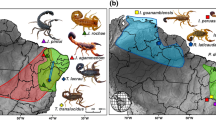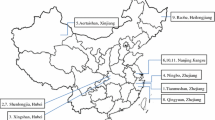Abstract
Chromosome number and morphology were studied in three allocreadiid species from mitotic metaphases of intramolluscan stages using karyometric analysis. Bunodera luciopercae has a diploid number 2n = 14, with two large pairs of metacentrics, one pair of submeta-subtelocentrics, and four pairs of acrocentrics. Karyotype of Allocreadium isoporum, 2n = 14, with two large pairs of metacentrics and five pairs of acrocentrics was recognized to be closely related to that of B. lucioperca. The most conspicuous interspecific difference occurs in the centromere position of the chromosomes of the pair 3. The possible reasons of the discrepancies between data reported therein and the karyological information previously published on these two species are discussed. Crepidostomum sp. has 2n = 12, with one pair of large metacentrics and five pairs of acrocentrics and is more distantly related karyologically to the other two members of the family. Evolutionary considerations based on comparison of the chromosomes of Allocreadiidae and other studied families of the suborder Xiphidiata suggest that allocreadiids are karyotypically distinct. The placement of Allocreadiidae and Opecoelidae in the superfamily Allocreadioidea is questioned.



Similar content being viewed by others
References
Barshene YaV, Orlovskaya OM (1990) Karyological studies on trematodes of families Allocreadiidae, Plagiorchiidae and Gorgoderidae from North-West Chukotka. Parazitologya 24:121–127, (in Russian)
Baršienė J (1993) The karyotypes of trematodes. Academia Vilnius (in Russian)
Britt HG (1947) Chromosomes of digenetic trematodes. Am Nat 81:276–296
Cable RM (1965) Thereby hangs a tail. J Parasitol 51:2–12
Caira JN (1989) A revision of the North American papillose Allocreadiidae (Digenea) with independent cladistic analyses of larval and adult forms. Bul Neb State Mus 11:1–58, (+195 figs)
Caira JN, Bogea T (2005) Family Allocreadiidae Looss, 1902. In: Jones A, Gibson DI, Bray RA (eds) Keys to the Trematoda, vol. 2. CAB International, Wallingford, pp 417–436
Cannon LRG (1971) The life cycles of Bunodera sacculata and (Trematoda: Allocreadiidae) in Algonquin Park, Ontario. Can J Zool 49:1417–1429
Choudhury A, Valdez RR, Johnson RC, Hoffmann B, de Leon GP-P (2007) The phylogenetic position of Allocreadiidae (Trematoda: Digenea) form partial sequences of the 18S and 28S ribosomal RNA genes. J Parasitol 93:192–196
Cribb TH (2005) Superfamily Allocreadioidea Looss, 1902. In: Jones A, Gibson DI, Bray RA (eds) Keys to the Trematoda, vol. 2. CAB International, Wallingford, pp 417–436
Curran SS, Tkach VV, Overstreet RM (2006) A review of Polylekithum Arnold, 1934 and its familiar affinities using morphological and molecular data, with description of Polylekithum catahoulensis sp. nov. Acta Parasitol 51:238–248
Dawes B (1946) The Trematoda, with special reference to British and European forms. Cambridge University Press, Cambridge
Dollfus RP (1949) Sur une cercaire ophthalmoxiphidiocerque Cercaria isopori A. Looss, 1894 et sur la délimitation des Allocreadioidea. Ann Parasitol Hum Comp 24:424–435
Fuhrmann O (1928) Zweite Klasse des cladus plathelminthes. Trematoda. In: Kükenthal W, Krumbach T (eds) Handbuch der Zoologie. Walter de Gruyter, Berlin, p 140, 2(2)
Gibson DI (1996) Trematoda. In: Margolis L, Kabata Z (eds) Guide to the parasites of fishes of Canada, Part IV. Canadian Special Publication of Fisheries and Aquatic Sciences No. 124, NRC Press, Ottawa
Hopkins SH (1933) The morphology, life histories and relationships of the papillose Allocreadiidae (Trematodes) (preliminary report). Zool Anz 103:65–74
Jones A, Bray RA, Gibson DI (2005) Keys to the Trematoda, vol. 2. CABI International Press, Cambridge
Levan A, Fredga K, Sandberg A (1964) Nomenclature for centromere position on chromosomes. Hereditas 52:201–220
Looss A (1894) Die Distomen unserer Fische und Frösche. Neue Undersuchungen über Bau und Entwickelung des Distomenkörpers. Bibliotheca Zoologica, Stuttgart 6:1–296
Madhavi R (1978) Life history of Allocreadium fasciatusi Kakaji, 1969 (Trematoda: Allocreadiidae) from the freshwater fish Aplocheilus melastigma McClelland. J Parasitol 52:51–59
Madhavi R (1980) Life history of Allocreadium handiai Pande, 1937 (Trematoda: Allocreadiidae) from the freshwater fish Channa punctata Bloch. Parasitol Res 63:89–97
Niewiadomska K, Valtonen ET (2007) Morphology, development and probable systematic position of Cercariaeum crassum Wesenberg-Lund, 1934 (Digenea), a parasite of Pisidium amnicum in eastern Finland. Syst Parasitol 68:147–154
Olson PD, Cribb TH, Tkach VV, Bray RA, Littlewood DTJ (2003) Phylogeny and classification of the Digenea (Platyhelminthes: Trematoda). Int J Parasitol 33:733–755
Petkevičiūtė R, Stanevičiūtė G (1999) Karyotypic characterization of Apatemon gracilis. J Helminthol 73:73–77
Petkevičiūtė R, Stanevičiūtė G, Kiselienė V (1995) Mitotic chromosomes of Sphaerostomum bramae (Müller, 1776) Szidat, 1944. J Helminthol 69:347–349
Petkevičiūtė R, Stunžėnas V, Stanevičiūtė G (2004) Cytogenetic and sequence comparison of adult Phyllodistomum (Digenea: Gorgoderidae) from the three-spined stickleback with larvae from two bivalves. Parasitology 129:771–778
Ramanjaneyulu JV, Madhavi R (1984) Cytological investigations on two species of allocreadiid trematodes with special references to the occurrence of triploidy and parthenogenesis in Allocreadium fasciatusi. Int J Parasitol 14:309–316
Skrjabin KI (1966) Family Allocreadiidae Stossich, 1903 (in Russian). In: Skrjabin KI (ed) Trematodes of animals and man. Osnovy Trematodologii 22:182–456
Sokolov SG, Tseitlin DG, Afanasyev KI, Malinina TV, Rubtsova GA (2006) A comparative study of two sympatric subspecies of trematodes, Bunodera luciopercae luciopercae (Müller, 1776) and B. l. acerinae Roitman et Sokolov, 1999 (Trematoda: Bunoderidae). Zoologya Bespozvonothnych 3:209–223, (in Russian)
Špakulova M, Casanova JC (2004) Current knowledge on B chromosomes in natural populations of helminth parasites: a review. Cytogenet Genome Res 106:222–229
Wiśniewski WL (1958) The development cycle of Bunodera luciopercae (O. F. Müller). Acta Parasitol Pol 6:289–307
Acknowledgments
We thank Dr. Eleonora Korol (Schmalhausen Institute of Zoology of National Academy of Sciences of Ukraine) for helping in collecting sphaeriid bivalves. This study was supported by the Lithuanian Science and Studies foundation research grant C-07002.
Author information
Authors and Affiliations
Corresponding author
Rights and permissions
About this article
Cite this article
Petkevičiūtė, R., Stanevičiūtė, G. Comparative karyological analysis of three members of Allocreadiidae (Digenea): taxonomic and phylogenetic implications. Parasitol Res 103, 1105–1110 (2008). https://doi.org/10.1007/s00436-008-1101-6
Received:
Accepted:
Published:
Issue Date:
DOI: https://doi.org/10.1007/s00436-008-1101-6




